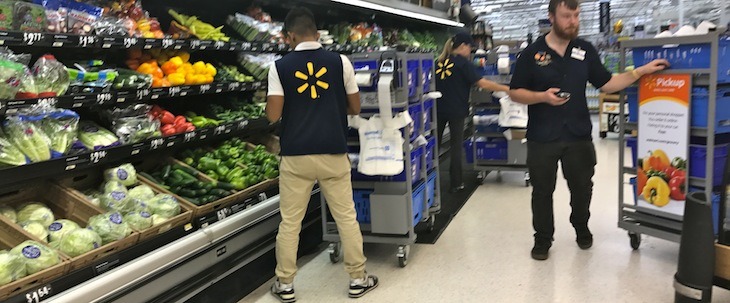Online grocery, new e-commerce brands part of better than expected quarter for Walmart
by May 17, 2018 4:46 pm 530 views

Walmart U.S. employees work to fill orders placed online for store pickup.
After somewhat dismal e-commerce results in Walmart’s fiscal fourth quarter, the retailer surprised investors Thursday (May 17) with a 33% jump in online sales for the quarter ending April 27.
Just last quarter, Walmart reduced online sales expectations and predicted 40% annual growth with most of that in the second half of the year.
“Online grocery continued to accelerate and [we] had the new Walmart.com site redesign late in the quarter. We also have new brands in e-commerce including the partnership with Lord & Taylor, so there are a lot of different things driving growth there,” CFO Brett Biggs told the media during Thursday’s earnings call.
Bentonville-based Walmart early Thursday (May 17) reported first quarter net income of $2.134 billion, down almost 30% compared to the $3.039 billion in the same quarter of the previous year. Total revenue in the quarter was $122.69 billion, up 4.4% compared with $117.542 billion in the same quarter of fiscal 2017. Per share earnings of $1.14 and the total revenue tally beat the consensus estimates.
Walmart shares (NYSE: WMT) closed Thursday at $84.49, down $1.64. During the past 52 weeks the share price has ranged between $73.13 and $109.98.
Marc Lore, CEO of Walmart U.S. e-commerce, told the media the new site redesign makes the grocery shopping options more prominent. He said between 10% and 20% of new customers are trying online grocery since the site launched. Online grocery added 1% to Walmart’s U.S. comp sales in the recent quarter.
Walmart President and CEO Doug McMillon said in prepared remarks the company is on track to increase online grocery pickup by roughly 1,000 new locations this year. Also, 800 stores will be used for filling online grocery orders with home delivery.
“The e-commerce food business we’ve been building is important not only because of the volume it’s driving but, strategically, it’s helping to grow the number of omni-channel customers we serve,” McMillon said. “You’ll remember from our previous presentations that omnichannel customers spend almost twice as much with us, and they also spend more in stores even after becoming omni-channel customers.”
WALMART U.S., SAM’S CLUB
The media asked Walmart U.S. CEO Greg Foran to provide more details about who else the retailer plans to use for home delivery services already being provided by PostMates and DoorDash. Foran said there are literally dozens of small final-mile startups in various communities around the country. He mentioned no names but said the retailer is linking into the highly fragmented market.
Selling groceries is a competitive business. Kroger announced Thursday an exclusive online delivery partnership with Ocado. Foran declined to comment on the Kroger news but said Walmart welcomes all competition. Also this week, Amazon announced more discounts at Whole Foods for Prime members.
Foran said Walmart continues to lower its prices, but didn’t disclose how much the so-called “investment” in lower prices is costing the retailer. He said the grocery business was strong in the recent quarter with healthy traffic across key categories. Walmart said fresh food and packaged goods drove low single-digit comp sales in the quarter. The retailer said gross margin dipped 0.23% because of the price “investments” and higher transportation costs.
“Overall, we’re pleased with the underlying strength in the Walmart U.S. business.,” Biggs said in the prepared remarks. “We’re finding new ways to leverage our stores to provide even more convenience through the expansion of pickup towers as well as online grocery pickup and delivery. We’re saving customers time and money, and they’re responding favorably.”
Sam’s Club had one of its best quarters in recent years, according to Biggs. Sam’s returned comp sales of 3.8% with traffic growth of 5.8%. McMillon said e-commerce contributed 0.25% to overall comp sales. A number of the clubs discontinued the sale of tobacco products and that represented a 1.4% drag on comp sales, he said.
“I’m excited by the focus [Sam’s Club CEO] John [Furner] is giving to the fresh food part of our business and the momentum the team is building,” McMillon said. “Members are responding to improved quality and freshness in fresh food, lower prices and more newness. The Sam’s team is also doing a good job driving growth in our private brand, Member’s Mark. Private brand penetration increased more than 2.2% year-over-year.”
MIXED GLOBAL RESULT
The international markets were a mixed bag as 8 of 11 delivered positive comp sales in the quarter. The combined comp sales for the international division rose 4.5% on a constant currency basis. Walmex led the way with same-store sales growth of 9.5%. Mexico reported 14.1% growth in comp sales on a two-year stack basis. Walmart said much of that growth came in brick and mortar as the smaller omnichannel sales rose 28%.
Comp sales in Canada rose 2.9%. Also in the quarter Walmart sold its Canadian Bank business which created a charge of $81 million to that business in the quarter. The retailer also sold land in Canada garnering $51 million. In China comp sales were 4% which was the best performance in more than five years. In the United Kingdom, Asda’s comp sales grew 3.4% in the quarter. Walmart is transitioning out of its majority ownership of Asda having recently sold a 62% stake to competitor Sainsbury.
Walmart made no mention of Japan, India (other than Flipkart), Chile, Brazil or Africa where it also operates. McMillon said the international segment delivered solid results overall and new CEO Judith McKenna hit the ground running with big announcements in the U.K. and India. He said she’s traveled to Canada, China, U.K., India and Mexico in the past three and half months since becoming head of Walmart International.
Walmart continues to shake up its international portfolio and insiders predict there will be more partnerships and possible divestitures in markets that have tapped out their growth opportunity.
